The Google Pixel C Review
by Brandon Chester & Joshua Ho on January 25, 2016 8:00 AM ESTDisplay Analysis
At the launch event for their new Nexus phones and the Pixel C, Google made a point of advertising the Pixel C’s display as a 2560x1800 panel with a 500nit brightness, a 1.422 aspect ratio, and a low-temperature polycrystalline silicon (LTPS) backplane. The use of LTPS doesn’t have a direct impact on the user as far as display accuracy is concerned, but it can help to lower power usage and increase brightness by reducing the size of light-blocking circuitry. This can also lead to longer battery life by reducing display power, as the backlights don’t need to be pushed to as high of a brightness.
The Pixel C’s aspect ratio is a very interesting choice. While one can consider the 4:3 aspect ratio of the iPad to be fairly close to a digitized sheet of 11 x 8.5” paper, the fact that most of the world uses A series paper which has a square root of two 2 aspect ratio makes the Pixel C especially well-suited for displaying those documents. It’s a wider aspect ratio than what you get with a 4:3 display, but not as wide as the one on a 16:10 Android tablet, and slightly less wide than Microsoft’s Surface Tablets which have a 3:2 aspect ratio. However, the Pixel C is still wide enough that you’re clearly intended to use it in a landscape orientation. Landscape doesn’t lend itself well to the majority of Android apps that just throw up a big phone UI and call it a day, and I feel that it may have been a mistake on Google’s part. A future update to enable split-screen multitasking may change things here, but for now you’re stuck with an interface and applications that just don’t feel at home on a display of these proportions.
Something that I felt worth noting about the Pixel C was how reflective the glass appears to be. While we don’t have a test for the exact reflectivity of a display, it’s something that can be fairly well gauged just by using the device and making comparative observations to other devices. All of the Android tablets I review are clearly more reflective than the latest iPads due to the lack of anti-reflective coatings, but the Pixel C really stands out for its high reflectance. I’ve had a number of issues using the Pixel C due to reflections making it impossible to see what’s on the screen, which means that I have to increase the brightness to compensate. This subsequently reduces the battery life because it increases the power consumed by the display. While Google is able to overcome these issues due to their high brightness, utilizing an anti-reflective coating to allow for visibility even with a low brightness allows for better real-world battery life.
In addition to fairly basic specifications like brightness, resolution, and aspect ratio, a display has many other aspects relating to color accuracy. On mobile platforms, a display must target the sRGB color standard to accurately render the content that one will find on the web, and through all video streaming and photo sharing services. To evaluate a display’s accuracy relative to the sRGB standard we run it through our custom display workflow, using an X-Rite i1Pro 2 spectrophotometer and i1Display Pro colorimeter along with SpectraCal’s CalMAN 5 software for collecting and managing the data.

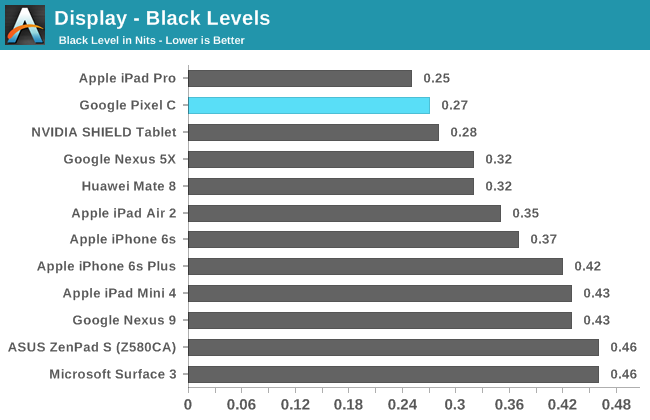
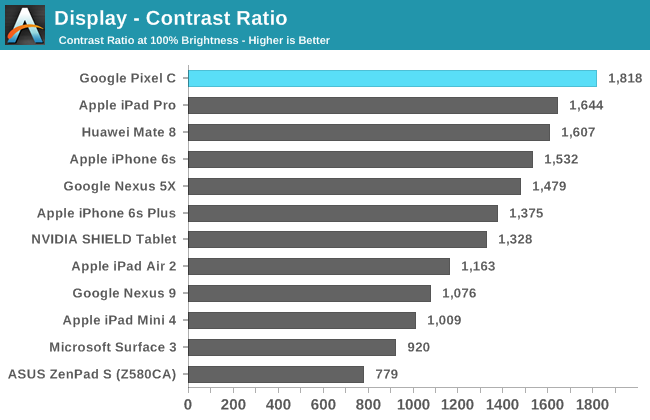
The Pixel C’s display goes up to 495 nits measured at the center of the display, and so Google was quite accurate in their advertisement of 500nits. This is the brightest tablet on record, beating the Nexus 9 by around 25 nits. As I mentioned earlier, the highly reflective glass makes the high brightness levels quite necessary, which will likely end up impacting the real-world battery life that Pixel C owners see. It’s also worth noting that the touch sensor layer is highly visible when light shines on the display, which makes it even more difficult to use outdoors or with overhead lighting. This is something that I’ve only seen managed well on Samsung and Apple devices, and for a flagship Android tablet with a completely custom display I expect better in this regard than what the Pixel C delivers.
In addition to the high brightness, the Pixel C has quite deep black levels for an LCD tablet. With a black level of 0.2718 nits and a contrast ratio of 1818 at max brightness, the Pixel C has the best contrast of any tablet that we’ve seen to date, besting even the iPad Pro.
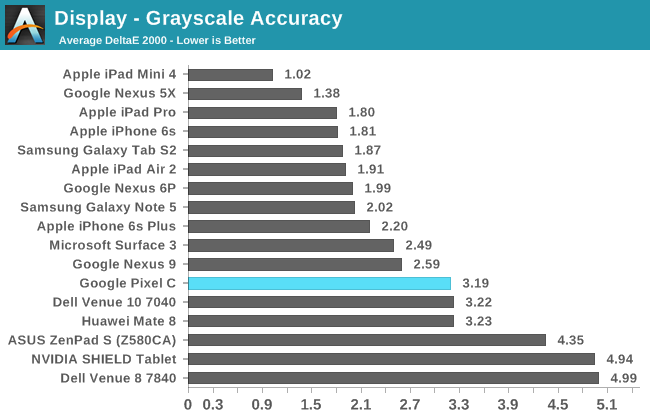
Greyscale accuracy on the Pixel C is fairly good, with a DeltaE error value slightly over the motion-visible value of 3. The error is mostly due to the green component of luminance dropping as you move from black to white. While we certainly have been spoiled by the rapid increase in mobile display quality over the last few years, I do think that Google could have pushed color accuracy higher here. That isn’t to say that I think the Pixel C will disappoint, but considering that it’s an entirely custom panel on a premium device that won’t be shipping in high volume, I think Google could have gone a bit further. Competition is getting fairly fierce in this category, with devices pushing for DeltaE values below 2, and some units achieving values below 1 which would make the error impossible for the eye to detect in any circumstance. In the end, the Pixel C’s greyscale accuracy is quite good, but it’s not the absolute best that I’ve seen.

The Pixel C’s accuracy with rendering primary and secondary color saturations is excellent. With an average DeltaE value below 2, I doubt any person will find themselves bothered by what little inaccuracy there is. The only color that actually exhibits an error above 3 is 100% red, with the remaining values all sitting below.
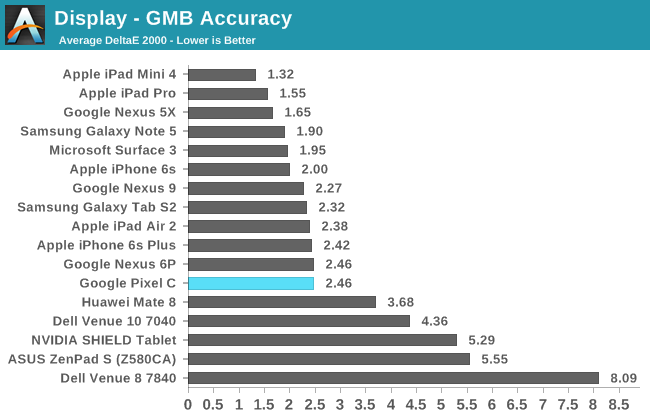
The Pixel C does quite well in the Gretag-MacBeth ColorChecker test. The average error is below 3, with the only outliers being color mixtures that primarily have a blue component, along with the greyscale values that are included in the test. Most other colors have DeltaE values somewhere between 1 and 2, and with that kind of accuracy I don’t really have any complaints, even if it’s not the absolute best result that I’ve ever seen.
In the end, the Pixel C comes with a bright, accurate, and high resolution display, with one of the highest contrast ratios that I’ve seen on a tablet. Google could definitely improve greyscale performance a little, and all companies need to start applying the same sort of anti-reflective coatings that Apple applies to their iPads, because the difference in outdoor usability is dramatic when you compare them. The Pixel C’s high reflectivity has been a noticeable obstacle when using it in environments that have overhead lighting, which includes my own home. That kind of little detail is the sort of thing that, when properly recognized and addressed, can really take a product to the next level. As it is, the Pixel C’s display is very good in many respects, but among high end tablets it’s not one I can call the absolute best.



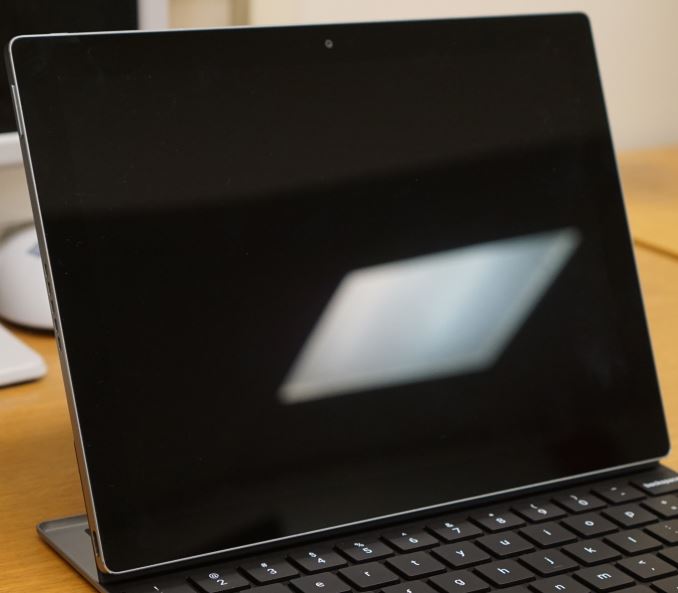
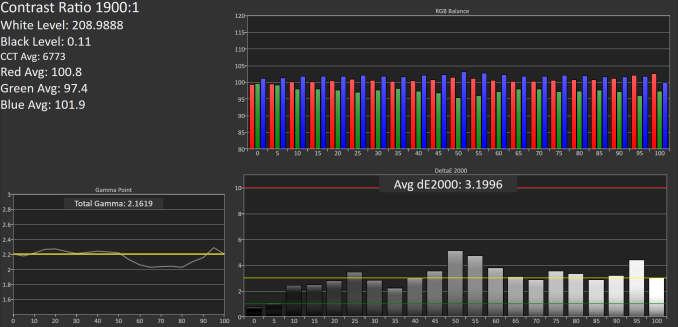

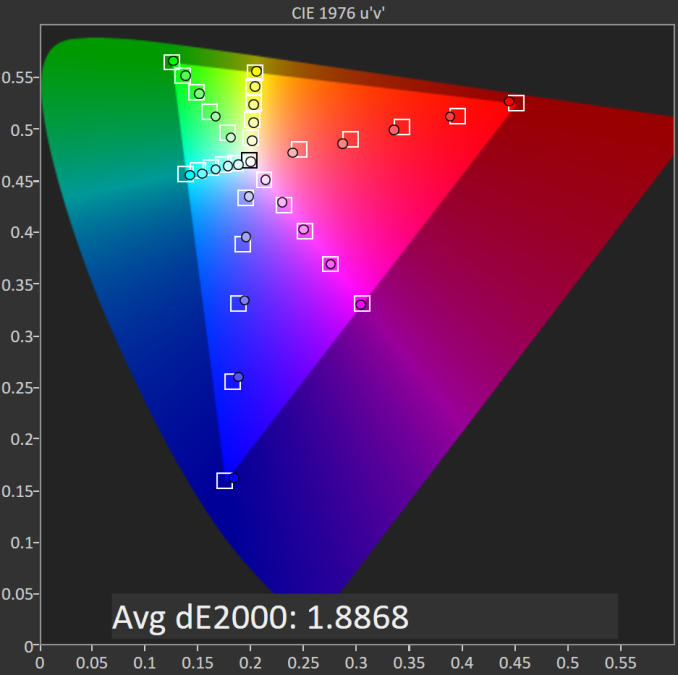









122 Comments
View All Comments
kurkosdr - Monday, January 25, 2016 - link
Split-screen is a problem devs aren't at fault, but Google.jbelkin - Monday, January 25, 2016 - link
Because android only sells when it's subsidized or discounted heavily. That is why android tablets sell fine at $99 but not beyond that. The facts are that android is only fit for low end products - look at Nest now, stops working periodically - an annoyance for a phone or a tablet but deadly when in cold climates when you need the temperature maintained ... but what does Google care* - as long as the tracking info arrives back, the rest - who cares? What, you want your "free" money back?* one reason why google is changing its name tio alphabet, non assiciation with google branding.
Speedfriend - Tuesday, January 26, 2016 - link
Android only fit for low end products? I use iOS and Android products on a daily basis and my Android phone is far more stable than my iPhone, many of my Android apps work better too. And don't get me start on iPhone reliability. The number of hours I have wasted in my life trying to get an iPhone repaired because the touchscreen or fingerprint reader has broken again. We use iPhone as our work phone and the reliability is awful compared to our laptops and PCs.vanilla_gorilla - Tuesday, January 26, 2016 - link
I've got right at 480 iOS devices registered in Air-Watch so my anecdote > your anecdote, and we don't have any of the problems you're describing. The only time an iPhone breaks is when someone drops it or the rash of iPhone 5 we had years ago with the battery issue (for which Apple had a replacement program).fastfreddy68 - Wednesday, March 29, 2017 - link
jbelkin I read your stupidity and cant hold back . Tablets dont sell much because the "niche" they had is gone. Phablets replaced it. Apple six plus is a direct result of the popularity of Samsungs NOTE 4 and f,,,, Android. The Google pixel isnt sold to the poor Rube it cost more then some Iphones.Obviously you are some FANBOY. I'll put my LG V20 up against your Iphone any day.People like Android because of the creativity it allows.
NFC and Waterproofing a direct result of Androids popularity. Claiming Android is only for the poor is so 5 years ago. Maybe instead of buying another Apple product you should buy a clue.!
extide - Monday, January 25, 2016 - link
While I agree the Asian desire for CORESSSSSSS is a bit off, I don't think it really has anything to do with it. Ultimately most people don't care what processor is in the tablet. They care is it slow/crappy? If not, its ok.The software ecosystem, on the other hand, is the big deal. Android is well known for not having many good tablet focused apps. That is a much bigger issue than the cpu and stuff. I mean obviously this thing has great build quality, that's not holding it back.
easp - Monday, January 25, 2016 - link
The lack of good Android tablet software is a problem, but the fact that the Android tablet and phone market is dominated by SoCs with too many cores and too little single-thread performance is a big problem.I don't think its fair to place blame solely at the feet of asian customers. Plenty of spec-obsessed western customers have taken the bait too.
The poor single core performance means that javascript web apps are slow, because Javascript engines are single threaded.
jbelkin - Monday, January 25, 2016 - link
it does matter. high spec high cost android tablets do not sell - just like $1,500 chromebooks or WIN PC's. The max price for an android tablet is $99 and $299 for a chromebook.johnnyzleong - Monday, January 25, 2016 - link
Wow,"The Google ecosystem is focused on ignorant third-world consumers that think more cores are somehow better than faster individual cores."
Holding a iPad makes you feel so good isn't it?
McDuncun - Tuesday, January 26, 2016 - link
That`s the problem man, the Apple Market is so heavily condensed... Not with rational people or a well rounded product line but with the smug bastardized self righteous fumes that all Apple owners exude from their well bleached orifices. Stigmas are there for a reason and yes I can be petty and still make a good argument.